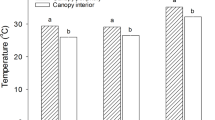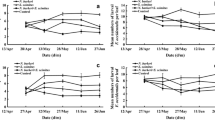Abstract
Conventional and biological control of a native moth, Dalaca pallens (Blanchard) (Lepidoptera: Hepialidae), were evaluated in Southern Chile in relation to changes on community metrics (diversity, species richness, evenness and dominance) of a soil-dwelling invertebrate assemblage. Two experiments were conducted (in winter and spring) to compare non-target effects of Beauveria bassiana (Balsamo) Vuillemin and lambda-cyhalothrin insecticide. The invertebrate community was sampled before and after spraying by extracting soil cores. Estimates of diversity (Shannon index), species richness, evenness (Hurlbert’s Probability of Interspecific Encounter) and dominance indicated that the invertebrate assemblage was strongly disturbed by lambda-cyhalothrin treatment but not by B. bassiana applied in winter, over the sampling period (40 days). Spring results revealed that diversity and evenness at control and at B. bassiana plots were similar between them and higher than at lambda-cyhalothrin plots, while there were no differences between sites 30 days after treatment in species richness. Inundative biological control using B. bassiana strain QU-B931 was considered to pose lower ecological risk than lambda-cyhalothrin, currently one of the most frequently used insecticides for D. pallens control.
Similar content being viewed by others
Abbreviations
- PIE:
-
probability of interspecific encounters
- UACH:
-
Universidad Austral de Chile
- A.I.:
-
active ingredient
- µl:
-
microliter
- INIA:
-
Instituto de Investigaciones Agropecuarias, Ministerio de Agricultura, Chile
References
Alves S.B., Almeida J., Moino A., Alves L.F. (1998). Técnicas de laboratório. In: Alves S.B. (ed) Controle microbiano de insetos. Fundacao de Estudos Agrários Luiz de Queiroz. Piracicaba, Brasil, pp. 637–711
Artigas J. (1994). Entomología económica Insectos de interés agrícola, forestal, médico y veterinario. Ediciones Universidad de Concepción,Concepción, Chile
Barbieri A., Veronesi M., Simona M., Malusardi S., Straskrabova V. (1999). Limnological survey in eight high mountain lakes located in Lago Maggiore watershed (Switzerland). J. Limn. 58(2):179–192
Brinkman M.A., Fuller B.W. (1999). Influence of Beauveria bassiana strain GHA on nontarget rangeland arthropod population. Environ. Entomol. 28(5):863–867
Carrillo R., González E., Neira M. (2003). Extracción de larvas y adultos de carábidos desde el suelo, comparación de métodos. Revista Chilena de Entomología 29:111–115
Chase A.R., Osborne L.S., Ferguson V.M. (1996). Selective isolation of the entomopathogenic fungi Beauveria bassiana and Metarhizium anisopliae from an artificial potting medium. Florida Entomol. 69:285–292
Cisternas E., Gerding M., France A. (2003). Uso del hongo Beauveria bassiana ¿Cómo controlar la cuncunilla negra de las praderas sin usar insecticidas? Informativo Agropecuario BIOLECHE INIA-Quilamapu 16(1):51–52
CSIRO. (1991). The Insects of Australia: A Textbook for Students and Research Workers, Vol. 1 & 2. Melbourne Univ. Press, Carlton Australia
Danfa A., van der Valk H.C. (1999). Laboratory testing of Metarhizium spp. and Beauveria bassiana on Sahelian non-target arthropods. Biocontrol Sci. Tech. 9:187–198
Dennis P. (2003). Sensitivity of upland arthropod diversity to livestock grazing, vegetation structure and landform. Food Agric. Environ. 1:301–307
Devotto, L., E. Cisternas and M. Gerding, 2003. Interacciones entre un ensamble de artrópodos y Beauveria bassiana utilizada como controlador biológico de Dalaca pallens (Lepidoptera: Hepialidae) en praderas. In: Resúmenes del XXV Congreso Nacional de Entomología, 26–28 de noviembre de 2003, Universidad de Talca, Talca, Chile
Ehrlich P.R., Ehrlich A.H. (1981). Extinction: The Causes and Consequences of the Disappearance of Species. Random House, New York USA
Ehrlich P.R., Wilson E.O. (1991). Biodiversity studies: science and policy. Science 253:758–762
Gotelli N.J., Colwell R.K. (2001). Quantifying biodiversity: procedures and pitfalls in the measurement and comparison of species richness. Ecol. Lett. 4:379–391
Gotelli, N.J. and G.L. Entsminger, 2004. EcoSim: null models software for ecology. Version 7. Acquired Intelligence Inc. & Kesey-Bear. Jericho, VT 05465. http://garyentsminger.com/ecosim.htm
Hardin M.R., Benrey B., Coll M., Lamp W.O., Roderick G.K., Barbosa P. (1995). Arthropod pest resurgence: an overview of potential mechanisms. Crop Prot.14:3–18
Hills O.A., Taylor E.A. (1951). Parasitization of dipterous leafminers in cantaloupes and lettuce in the Salt River Valley, Arizona. J. Econ. Entomol. 44:759–762
Hurlbert S.H. (1971). The nonconcept of species diversity: a critique and alternative parameters. Ecology 52:577–586
Ivie M.A., Pollock D.A., Gustafson D.L., Rasolomandimby J., Ivie L.L., Swearingena W.D. (2002). Field-based evaluation of biopesticide impacts on native biodiversity: Malagasy Coleoptera and anti-locust entomopathogenic fungi. J. Econ. Entomol. 95(4):651–660
Jayanthi P.D.K., Padmavathamma K. (1996). Cross infectivity and safety of nuclear polyhedrosis virus, Bacillus thuringiensis subsp. kurstaki Berliner and Beauveria bassiana (Balsamo) Vuillemin to pests of groundnut (Arachis hypogaea Linn.) and their natural enemies. J. Entomol. Res. 20:211–215
Kenmore P.E., Cariño F., Perez C., Dyck V., Gutierrez A. (1984). Population regulation of the rice brown planthopper (Nilaparvata lugens Stal) within rice fields in the Philippines. J. Plant Prot. Tropics 1:1–37
Lawton J.H. (1994). What do species do in ecosystems? Oikos 71:367–374
Niehoff B., Küneke U., Klein J., Poehling M.H. (1994). Impact of different rates of lambda-cyhalothrin on spiders and staphylinids in winter wheat. Med. Fac. Landbouww. Univ. Gent. 59(2):335–345
Nowak J.T., Mccravy K.W., Fettig C.J., Berisford C.W. (2001). Susceptibility of adult hymenopteran parasitoids of the Nantucket pine tip moth (Lepidoptera: Tortricidae) to broad-spectrum and biorational insecticides in a laboratory study. J. Econ. Entomol. 94:1122–1129
Settle W.H., Ariawan H., Astuti E.T., Cahyana W., Hakim A.L., Hindayana D., Lestari A.S., Sartanto P. (1996). Managing tropical pests through conservation of generalist natural enemies and alternative prey. Ecology 77:1975–1988
Spratt D.M. (1997). Endoparasite control strategies: implications for biodiversity of native fauna. Int. J. Parasitol. 27:173–180
Steenberg T., Langer V., Esbjerg P. (1995). Entomopathogenic fungi in predatory beetles (Coleoptera: Carabidae and Staphylinidae) from agricultural fields. Entomophaga 40:77–85
Swift M.J., Vandermeer J., Ramakrishnan P.S., Anderson J.M., Ong C.K., Hawkins B.A. (1996). Biodiversity and agroecosystem function. In: Mooney H.A., Cushman J.H., Medina E., Sala O.E., Schulze E.D. (eds), Functional Roles of Biodiversity: A Global Perspective. John Wiley and Sons, New York, USA, pp. 261–298
Tillman P.G., Mulrooney J.E. (2000). Effect of selected insecticides on the natural enemies Coleomegilla maculata and Hippodamia convergens (Coleoptera: Coccinellidae), Geocoris punctipes (Hemiptera: Lygaeidae), and Bracon mellitor, Cardiochiles nigriceps, and Cotesia marginiventris (Hymenoptera: Braconidae) in cotton. J. Econ. Entomol. 93:1638–1643
Traugott, M., H. Strasser and U. Priester, 2000. Impact of the entomopathogenous fungi Beauveria brongniartii on non-target carabid larvae representing beneficial invertebrates. In: IFOAM 2000 The World grows organic. 13th International IFOAM Scientific Conference and Accompanying Events, Basel, Switzerland, August 28–31, 2000, p. 143
van den Berg H., Asan K., Marzuki M. (1998). Evaluation of pesticide effects on arthropod predator populations in soya bean in farmers’ fields. Biocontrol Sci. Technol. 8:125
Walker B. (1992). Biological diversity and ecological redundancy. Conserv. Biol. 6:18–23
Wang C., Fan M., Li Z., Butt T.M. (2004). Molecular monitoring and evaluation of the application of the insect-pathogenic fungus Beauveria bassiana in Southeast China. J. Appl. Microbiol. 96:861–870
Wang Y., Crocker R.L., Wilson L.T., Smart G., Wei X., Nailon W.T., Cobb P.P. (2001). Effect of nematode and fungal treatments on nontarget turfgrass-inhabiting arthropod and nematode populations. Environ. Entomol. 30:196–203
Acknowledgements
We thank David Vázquez and Howard Thistlewood for statistical advice and for comments on the manuscript, respectively, and Leticia Silvestre for carabid identification. Funding was provided by the Dirección de Investigación y Desarrollo, Universidad Austral de Chile, through Project DID D-2003-2. LD was supported by MECESUP AUS-9904.
Author information
Authors and Affiliations
Corresponding author
Rights and permissions
About this article
Cite this article
Devotto, L., Cisternas, E., Gerding, M. et al. Response of grassland soil arthropod community to biological and conventional control of a native moth: using Beauveria bassiana and lambda-cyhalothrin for Dalaca pallens (Lepidoptera: Hepialidae) suppression. BioControl 52, 507–531 (2007). https://doi.org/10.1007/s10526-006-9037-1
Received:
Accepted:
Published:
Issue Date:
DOI: https://doi.org/10.1007/s10526-006-9037-1




